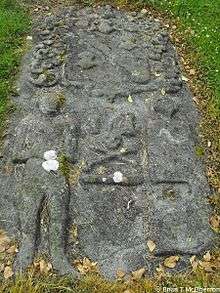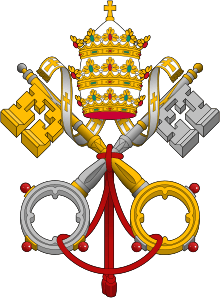Archdeacon of Kells
The Archdeacon of Kells (Middle English: Kenlys, Kenlis Irish: Ceanannas), alias the Archdeacon of Nobber (Middle English: Nobire, Nobbir, Nobyre, Irish: an Obair, meaning "the work"), was a medieval ecclesiastical post in the Diocese of Meath in the Kingdom of Meath, Ireland. The Archdeaconry was officially established sometime between the 11th and 13th centuries, and was annexed to the Rectory of Nobber. In the 16th Century, the office was briefly united to the Bishopric of Meath, but afterwards separated again. As a consequence of the Reformation, the Archbishop of Armagh (Church of Ireland) held the "Archdeacony of Kells, in commendam 1569 to 1584". Sometime before 1622, the Archdeacon of Kells and Rectory of Nobber were permanently united to the bishopric of Meath.
Archdeacon of Kells | |
|---|---|
 Motif in old Nobber graveyard, male figure wearing a Mitre | |
| Church | Catholic Church in Medieval Ireland |
| Archdiocese | Diocese of Meath |
| Province | Kingdom of Meath |
| See | Bishop of Meath |
| Quashed | before 1622 |
Background
Before the dissolution of the Monasteries and Henrican reforms of the 16th century took full effect in Ireland, there were Archdeacons of Kells, County Meath. The Diocese of Kells was established sometime after the Synod of Kells (1152), and incorporated with the Diocese of Meath after 1211. The deanery of Kells was created by Simon (de) Rochford, Bishop of Meath, in 1216.[1] At the time, it was one of twelve rural deaneries in Meath, later becoming one of the two archdeaconries of the same diocese.[2]
Nobber was once an important town in the Kingdom of Meath, and the Rectory of Nobber was united to this dignity; thus the holder was sometimes called Rector of Nobber, Parson of Nobber, or most commonly styled Archdeacon of Nobber.[3][4] In medieval times, "Kells" is called Middle English: Kenlys, Kenlis, Keneleis, Keneles, with "Nobber" expressed as Middle English: Nobire, Nobbir, Nobir, Nebyre, Nobyre, Nober. Confusingly, the archdeacon of Kells held the Rectory of Nobber, while the archdeacon of Meath held the Rectory of Kells.[5][n 1]
Archdeacons
|
In the High Middle Ages it was the most senior diocesan position below a bishop in the Roman Catholic Church. An archdeacon is often responsible for administration within an archdeaconry, which is the principal subdivision of the diocese. It is nearly impossible to fully catalogue the succession of holders of this ancient office.[7] Nonetheless, the information below is preserved.
.svg.png) DissolutionIn 1543, Edward Staples, Bishop of Meath, appropriated the Archdeaconry of Kells and the Rectory of Nobber to his Episcopal see,[8] or rather the temporalities of the offices.[43] The union was sealed by license from the king, dated 27 December 1544.[44] Nonetheless, the Archdeaconry of Kells expressed itself again in 1547, with Thomas Lockwood still incumbent. The reason for the brief union of offices is unclear, but it is known many religious houses in Ireland resisted dissolution until well into the reign of Elizabeth I. On 12 March 1569, Thomas Lancaster, an English Protestant clergyman, consecrated Archbishop of Armagh (Church of Ireland) on 12 June 1568, was given license to hold in commendam the post of archdeaconry of kells, and the rectory of Nobber.[41] According to the "Regal Visitation Book", sometime before 1622, the office of "Archdeaconry of kells, or Nobber", was permanently united to the bishopric of Meath.[4] Notes and referencesNotes
Citations
Primary sources
Secondary sources
Bibliography
|
